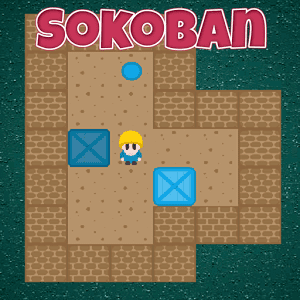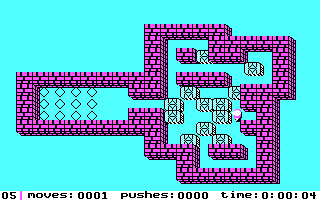8.4 /10 1 Votes8.4
4/5 Mind Games | 4.4/5 Google Play | |||||||||||||||||||||||||||||||||
 | ||||||||||||||||||||||||||||||||||
Similar Tetris, Boxxle, Supaplex, Minesweeper, Zuma | ||||||||||||||||||||||||||||||||||
Sokoban (倉庫番, sōkoban, warehouse keeper) is a type of transport puzzle, in which the player pushes boxes or crates around in a warehouse, trying to get them to storage locations. The puzzle is usually implemented as a video game.
Contents
- Sokoban level 8 solution
- Rules
- Sokoban published by Thinking Rabbit
- Sokoban published by Spectrum HoloByte
- Implementations of Sokoban
- Scientific research on Sokoban
- Sokoban variants
- References

Sokoban was created in 1981 by Hiroyuki Imabayashi, and published in 1982 by Thinking Rabbit, a software house based in Takarazuka, Japan.
Sokoban level 8 solution
Rules

The game is played on a board of squares, where each square is a floor or a wall. Some floor squares contain boxes, and some floor squares are marked as storage locations.

The player is confined to the board, and may move horizontally or vertically onto empty squares (never through walls or boxes). The player can also move into a box, which pushes it into the square beyond. Boxes may not be pushed into other boxes or walls, and they cannot be pulled. The puzzle is solved when all boxes are at storage locations.
Sokoban published by Thinking Rabbit
Sokoban published by Spectrum HoloByte
In 1988 Sokoban was published in US by Spectrum HoloByte as Soko-Ban for the IBM-PC and compatible computers, Commodore 64, and Apple II series. A review in Computer Gaming World praised the game for being "pure and simple, very playable and mentally challenging", citing its addictive qualities. It was also reviewed in Dragon giving it 4½ out of 5 stars.
Implementations of Sokoban
Implementations of Sokoban have been written for numerous computer platforms, including almost all home computer and personal computer systems. Versions also exist for video game consoles, mobile phones, graphic calculators and digital cameras.
Scientific research on Sokoban
Sokoban can be studied using the theory of computational complexity. The problem of solving Sokoban puzzles was proven to be NP-hard. Further work showed that it was significantly more difficult than NP problems; it is PSPACE-complete. This is also interesting for artificial intelligence researchers, because solving Sokoban can be compared to the automated planning that needs to be done by a robot that moves boxes in a warehouse.
Sokoban is difficult not only due to its branching factor (which is comparable to chess), but also its enormous search tree depth; some levels can be extended indefinitely, with each iteration requiring an exponentially growing number of moves and pushes. Skilled human players rely mostly on heuristics; they are usually able to quickly discard futile or redundant lines of play, and recognize patterns and subgoals, drastically cutting down on the amount of search.
Some Sokoban puzzles can be solved automatically by using a single-agent search algorithm, such as IDA*, enhanced by several techniques which make use of domain-specific knowledge. This is the method used by Rolling Stone, a Sokoban solver developed by the University of Alberta GAMES Group. The more complex Sokoban levels are, however, out of reach even for the best automated solvers.
Sokoban variants
Several puzzles can be considered variants of the original Sokoban game, in the sense that they all make use of a controllable character who pushes boxes around a maze.
Alternative tilings: In the standard game, the mazes are laid out on a square grid. Several variants apply the rules of Sokoban to mazes laid out on other tilings. Hexoban uses regular hexagons and Trioban uses equilateral triangles.
Alternative pushers: In the variants Multiban and Interlock the player can control multiple characters. In some games the pusher is a small bulldozer.
Alternative goals: Several variants adjust the requirements for completing a level. For example, in Block-o-Mania the boxes have different colours, and the goal is to push them onto squares with matching colours. Sokomind Plus implements a similar idea, with boxes and target squares uniquely numbered. In Interlock and Sokolor, the boxes also have different colours, but the goal is to move them so that similarly coloured boxes are adjacent. In CyberBox, each level has a designated exit square, and the goal is to reach that exit. In a variant called Beanstalk, the elements of the level must be pushed onto the goal in a fixed sequence.
Additional game elements: Push Crate, Sokonex, Xsok, Cyberbox and Block-o-Mania all add new elements to the basic puzzle. Examples include holes, teleports, moving blocks and one-way passages.
Character actions: In Pukoban, the character can pull boxes in addition to pushing them.
Reverse mode: The player solves the puzzle backwards, from the end to the initial position by pulling instead of pushing boxes. Standard Sokoban puzzles can be played in reverse mode, and the reverse-mode solutions can be converted to solutions for the standard-mode puzzle. Therefore, reverse mode can also be considered a tool for solving standard Sokoban puzzles.
